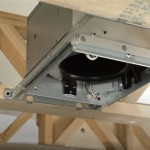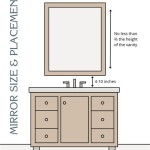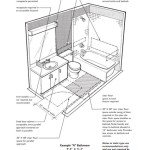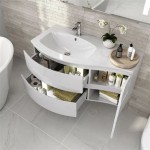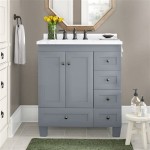30 Inch Unfinished Bathroom Vanity Base Cabinet: A Comprehensive Guide
A 30-inch unfinished bathroom vanity base cabinet serves as the foundation for a functional and aesthetically pleasing bathroom. This particular size is ideal for smaller bathrooms, powder rooms, or renovations requiring a compact yet practical storage solution. The "unfinished" aspect provides the homeowner or contractor with the freedom to customize the cabinet's appearance to perfectly match the existing décor or create a personalized design statement. Selecting the right cabinet involves careful consideration of materials, construction, design elements, and finishing options.
The term "30 inch" refers to the width of the cabinet. The depth and height can vary slightly depending on the manufacturer and style. Standard depths typically range from 18 to 21 inches, while height often falls between 30 and 34 inches. Before making a purchase, it is crucial to confirm the exact dimensions to ensure a proper fit within the designated bathroom space. Furthermore, accounting for plumbing considerations, such as drain placement and water supply lines, is essential for a seamless installation.
The advantage of an unfinished vanity lies in its adaptability. The raw wood surface allows for staining, painting, or even distressing techniques to achieve the desired look. This versatility significantly reduces costs compared to purchasing a pre-finished vanity, as the labor and materials associated with the finishing process are the responsibility of the buyer. The ability to select specific finishes also ensures greater control over the final appearance and durability of the cabinet.
Key Considerations Before Purchasing
Several factors should be carefully evaluated before acquiring a 30-inch unfinished bathroom vanity base cabinet. These considerations encompass the intended use, the existing bathroom layout, and the desired aesthetic. Overlooking these aspects can lead to dissatisfaction with the final product and potentially costly rework during the installation process.
First, assess the storage requirements. Consider the items that will be stored within the vanity, such as toiletries, cleaning supplies, and towels. Determine whether drawers, shelves, or a combination of both will best accommodate these needs. Some vanities feature a single door concealing an open storage area, while others incorporate multiple drawers for organized storage. The internal configuration should align with the specific storage demands.
Second, examine the plumbing configuration. The location of the water supply lines and drainpipe will dictate the necessary cutouts and modifications to the cabinet. Some unfinished vanities come with pre-cut openings, while others require custom modifications. It is advisable to consult with a plumber to ensure the cabinet design is compatible with the existing plumbing system. Avoid purchasing a vanity that necessitates extensive plumbing alterations, as this can significantly increase the overall project cost.
Third, consider the overall style of the bathroom. The vanity should complement the existing fixtures, flooring, and wall color. Unfinished vanities offer the flexibility to match any design aesthetic, from traditional to contemporary. However, it is essential to select a style that aligns with the overall design vision. Simple, clean lines are often suitable for modern bathrooms, while more ornate designs may be appropriate for traditional settings. Before purchasing, gather inspiration from magazines, online resources, or showrooms to determine the desired style.
Material Selection and Construction Quality
The materials used in the construction of the vanity directly impact its durability, longevity, and overall appearance. Selecting high-quality materials and examining the construction techniques are crucial steps in ensuring a worthwhile investment. Common materials include solid wood, plywood, medium-density fiberboard (MDF), and particleboard.
Solid wood is generally considered the most durable and aesthetically pleasing option. It offers natural beauty, strength, and resistance to moisture. However, solid wood can be more expensive and susceptible to warping or cracking if not properly sealed and maintained. Common wood species used in vanity construction include oak, maple, birch, and cherry.
Plywood is a cost-effective alternative to solid wood. It consists of multiple layers of wood veneer glued together, providing excellent strength and stability. Plywood is less susceptible to warping than solid wood and offers good moisture resistance when properly finished. Look for plywood that is specifically designed for cabinet construction, as it will have a smoother surface and fewer voids.
MDF is an engineered wood product made from wood fibers and resin. It is a stable and affordable option that provides a smooth surface for painting or staining. MDF is less resistant to moisture than solid wood or plywood, so it should be carefully sealed to prevent damage. MDF is often used for cabinet doors and drawer fronts.
Particleboard is the least expensive option, but it is also the least durable. It is made from wood particles and resin, and it is highly susceptible to moisture damage. Particleboard is typically used for less critical components of the vanity, such as the back panels or drawer bottoms. Avoid purchasing vanities that are primarily constructed from particleboard.
In addition to the materials, examine the construction techniques used to assemble the vanity. Look for solid joints, such as dovetail joints for drawers and mortise-and-tenon joints for cabinet frames. Ensure that the hardware, such as hinges and drawer slides, is of good quality and properly installed. A well-constructed vanity will be sturdy and durable, providing years of reliable service.
Finishing Techniques and Customization Options
The unfinished nature of the vanity provides a blank canvas for customization. Selecting the appropriate finishing techniques can transform a plain cabinet into a stunning focal point in the bathroom. Various options are available, each offering a unique aesthetic and level of protection.
Staining is a popular choice for highlighting the natural beauty of the wood grain. Stains are available in a wide range of colors, from light and natural to dark and dramatic. Before staining, the wood surface should be properly sanded to remove any imperfections. Apply the stain evenly and allow it to dry completely before applying a protective topcoat.
Painting offers a greater range of color options than staining. Paint can be used to create a bold, modern look or a subtle, classic feel. Select a high-quality paint that is specifically designed for use on wood. Apply several thin coats of paint, allowing each coat to dry completely before applying the next. A primer should be applied before painting to ensure proper adhesion and coverage.
Distressing techniques can be used to create a rustic or vintage look. These techniques involve intentionally damaging the surface of the wood to simulate wear and tear. Common distressing techniques include sanding edges, creating scratches, and applying antiquing glazes. Distressing can add character and charm to an otherwise plain vanity.
Regardless of the finishing technique chosen, it is essential to apply a protective topcoat. A topcoat will protect the finish from moisture, scratches, and stains. Common topcoat options include polyurethane, varnish, and lacquer. Select a topcoat that is compatible with the chosen finish and follow the manufacturer's instructions for application.
Beyond staining, painting, and distressing, other customization options can further personalize the vanity. Consider adding decorative hardware, such as knobs and pulls, to complement the overall style. Replace the standard countertop with a custom-made countertop from materials like granite, quartz, or marble. Install under-cabinet lighting to add ambiance and functionality. These small details can significantly enhance the appearance and functionality of the vanity.
In conclusion, selecting a 30-inch unfinished bathroom vanity base cabinet is a project that requires careful evaluation of several key aspects. From assessing storage needs and plumbing configurations to selecting optimal materials and construction techniques, each decision plays a crucial role in achieving a desired result. The flexibility offered by unfinished vanities allows for extensive personalization through various finishing techniques, ensuring the final product harmonizes with the bathroom's overall aesthetic and meets the specific needs of the user.

Project Source Unfinished 30 In Natural Rustic Oak Bathroom Vanity Base Cabinet Without Top The Vanities Tops Department At Com

Vanity Base 30 Jamestown Unfinished Kitchen Cabinet Right Drawers Seconds Surplus

Project Source Unfinished 30 In Natural Rustic Oak Bathroom Vanity Base Cabinet Without Top The Vanities Tops Department At Com

Project Source Unfinished 30 In Natural Rustic Oak Bathroom Vanity Base Cabinet Without Top The Vanities Tops Department At Com

Project Source Unfinished 30 In Natural Rustic Oak Bathroom Vanity Base Cabinet Without Top The Vanities Tops Department At Com

30 Vippis Unfinished Red Oak Raised Panel Vanity For Vessel Sink 34

Narrow Red Oak Vanity For Vessel Sink Unfinished Bathroom

Hampton Bay Easthaven Assembled 30x34 5x24 In Frameless Sink Base Cabinet With False Drawer Front Unfinished Beech Eh3035s Gb The Home Depot

Hampton Bay 30 In W X 24 D 34 5 H Assembled Base Kitchen Cabinet Unfinished With Recessed Panel Kb30 Uf The Home Depot

4 Drawer Vanity Base 12 Jamestown Unfinished Kitchen Cabinet Seconds Surplus
Related Posts


